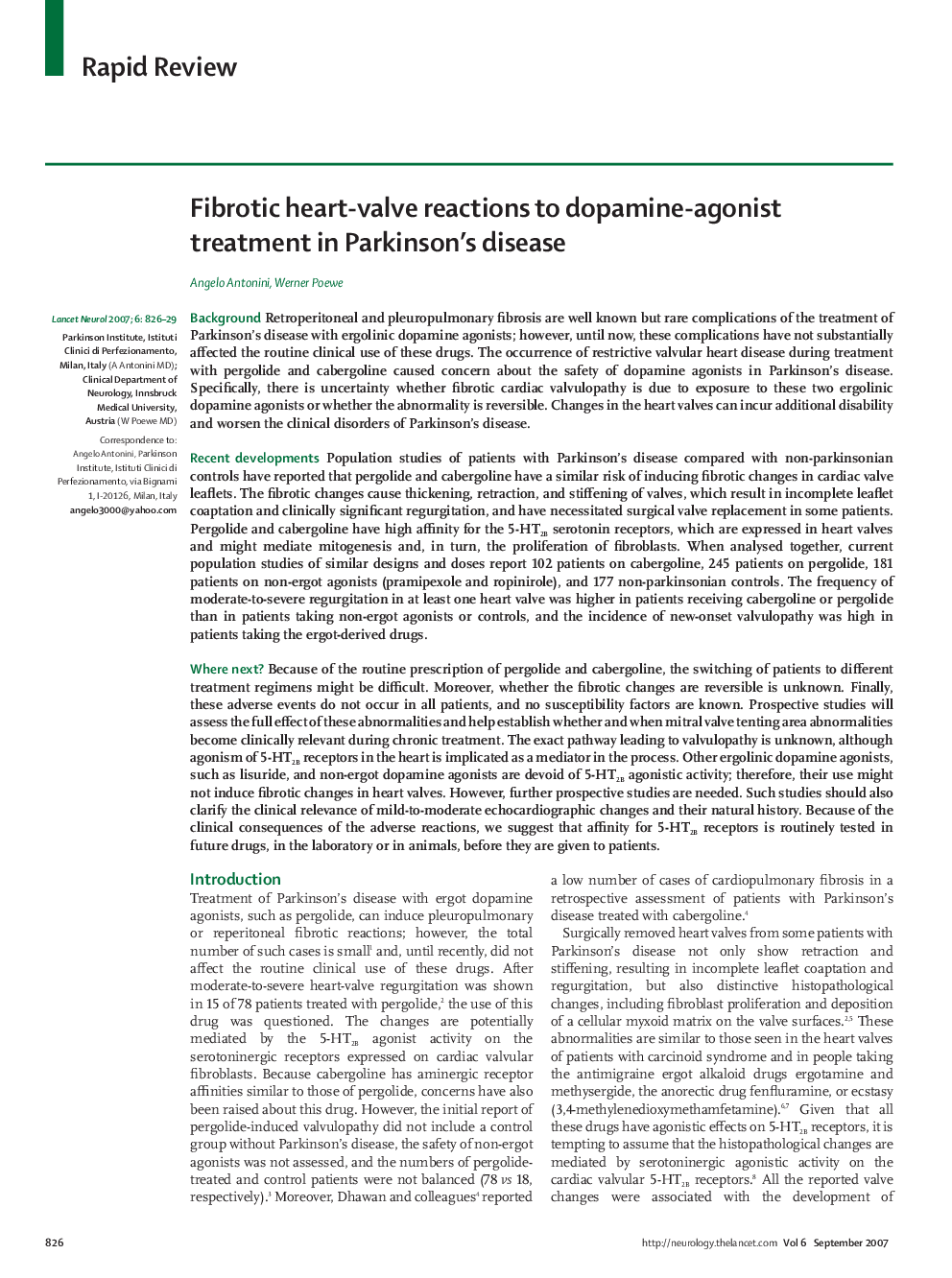| کد مقاله | کد نشریه | سال انتشار | مقاله انگلیسی | نسخه تمام متن |
|---|---|---|---|---|
| 3067659 | 1188164 | 2007 | 4 صفحه PDF | دانلود رایگان |

SummaryBackgroundRetroperitoneal and pleuropulmonary fibrosis are well known but rare complications of the treatment of Parkinson's disease with ergolinic dopamine agonists; however, until now, these complications have not substantially affected the routine clinical use of these drugs. The occurrence of restrictive valvular heart disease during treatment with pergolide and cabergoline caused concern about the safety of dopamine agonists in Parkinson's disease. Specifically, there is uncertainty whether fibrotic cardiac valvulopathy is due to exposure to these two ergolinic dopamine agonists or whether the abnormality is reversible. Changes in the heart valves can incur additional disability and worsen the clinical disorders of Parkinson's disease.Recent developmentsPopulation studies of patients with Parkinson's disease compared with non-parkinsonian controls have reported that pergolide and cabergoline have a similar risk of inducing fibrotic changes in cardiac valve leaflets. The fibrotic changes cause thickening, retraction, and stiffening of valves, which result in incomplete leaflet coaptation and clinically significant regurgitation, and have necessitated surgical valve replacement in some patients. Pergolide and cabergoline have high affinity for the 5-HT2B serotonin receptors, which are expressed in heart valves and might mediate mitogenesis and, in turn, the proliferation of fibroblasts. When analysed together, current population studies of similar designs and doses report 102 patients on cabergoline, 245 patients on pergolide, 181 patients on non-ergot agonists (pramipexole and ropinirole), and 177 non-parkinsonian controls. The frequency of moderate-to-severe regurgitation in at least one heart valve was higher in patients receiving cabergoline or pergolide than in patients taking non-ergot agonists or controls, and the incidence of new-onset valvulopathy was high in patients taking the ergot-derived drugs.Where next?Because of the routine prescription of pergolide and cabergoline, the switching of patients to different treatment regimens might be difficult. Moreover, whether the fibrotic changes are reversible is unknown. Finally, these adverse events do not occur in all patients, and no susceptibility factors are known. Prospective studies will assess the full effect of these abnormalities and help establish whether and when mitral valve tenting area abnormalities become clinically relevant during chronic treatment. The exact pathway leading to valvulopathy is unknown, although agonism of 5-HT2B receptors in the heart is implicated as a mediator in the process. Other ergolinic dopamine agonists, such as lisuride, and non-ergot dopamine agonists are devoid of 5-HT2B agonistic activity; therefore, their use might not induce fibrotic changes in heart valves. However, further prospective studies are needed. Such studies should also clarify the clinical relevance of mild-to-moderate echocardiographic changes and their natural history. Because of the clinical consequences of the adverse reactions, we suggest that affinity for 5-HT2B receptors is routinely tested in future drugs, in the laboratory or in animals, before they are given to patients.
Journal: - Volume 6, Issue 9, September 2007, Pages 826–829